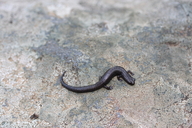|
Chiropterotriton perotensis Parra-Olea, García-Castillo, Rovito, Maisano, Hanken & Wake, 2020
Valle Alegre Salamander, Salamander de Valle Alegre | family: Plethodontidae subfamily: Hemidactyliinae genus: Chiropterotriton |
| Species Description: Parra Olea G, Garcia-Castillo MG, Rovito SM, Maisano JA, Hanken J, Wake DB. 2020. Descriptions of five new species of the salamander genus Chiropterotriton (Caudata: Plethodontidae) from eastern Mexico and the status of three currently recognized taxa. PeerJ 8:e8800 DOI 10.7717/peerj.8800 | |
 © 2020 Sean Michael Rovito (1 of 9) |
|
|
|
Description DIAGNOSIS: Chiropterotriton perotensis has smaller eyes than other species in the genus. Its manus and pes are also less prominent compared to other species of the genus such as C. aureus, C. casasi, C. ceronorum, C. chiropterus, C. lavae, C. melipona, C. nubilus, C. orculus, and C. totonacus . The outermost digit in the metatarsal region also protrudes less than in other species of Chiropterotriton. Its tail is shorter than those of C. aureus and C. totonacus (Parra Olea et al. 2020). Lastly, in most other species of Chiropterotriton, males tend to be smaller than females on average; the opposite is true for C. perotensis, with males tending to be larger than females (Campbell et al. 2014). COLORATION: In life, C. perotensis is generally dark in coloration with a reddish-brown dorsal stripe. The dorsal stripe can also be brownish gray in color. The underside of this species is dark. The iris is golden to dark brown (Parra Olea et al. 2020). In preservative, C. perotensis is uniformly dark brown with a paler underside. The tail is slightly darker blackish with a dark brown underside (Parra Olea et al. 2020). VARIATION: Individuals of this species vary in coloration and patterning. Other specimens are dark with fine white speckles and dark brown mottling. Additionally, the limbs can be dark brown, the underside dark, and the iris brownish black (Parra Olea et al. 2020). Distribution and Habitat Country distribution from AmphibiaWeb's database: Mexico
Life History, Abundance, Activity, and Special Behaviors Other species found in sympatry with this species include Aquiloeurycea cephalica, Isthmura naucampatepetl, Pseudoeurycea leprosa and P. melanomolga (Parra Olea et al. 2020). Trends and Threats Possible reasons for amphibian decline General habitat alteration and loss Comments PHYLOGENETIC RELATIONSHIPS: Based on Maximum Likelihood and Bayesian Inference of an mtDNA fragment that includes 12S, tRNA, and 16S and another fragment of COI, C. perotensis is a plethodontid salamander that’s related to C. lavae, C. ceronorum, and C. totonacus. More specifically, it is sister to C. lavae and together they are sister to the clade composed of C. ceronorum, and C. totonacus (Para Olea et al. 2020).ETYMOLOGY: The species epithet, “perotensis”, refers to the Cofre de Perote volcano where the species can be found (Parra Olea et al. 2020).
References
Campbell, J. A., Streicher, J. W., Cox, C. L., Brodie, E. D. (2014). “A new Salamander of the genus Chiropterotriton (Caudata: Plethodontidae) from the Sierra Madre Oriental of Tamaulipas, Mexico.” South American Journal of Herpetology, 9(3), 228-234. [link] Parra Olea, G., Garcia-Castillo, M. G., Rovito, S. M., Maisano, J. A., Hanken, J., Wake, D. B. (2020). “Descriptions of five new species of the salamander genus Chiropterotriton (Caudata: Plethodontidae) from eastern Mexico and the status of three currently recognized taxa.” PeerJ, 8:e8800 [link] Originally submitted by: Lisa Pacumio, Calvin Proctor, Parker Vornholt (2021-06-28) Description by: Lisa Pacumio, Calvin Proctor, Parker Vornholt (updated 2021-06-28)
Distribution by: Lisa Pacumio, Calvin Proctor, Parker Vornholt (updated 2021-06-28)
Life history by: Lisa Pacumio, Calvin Proctor, Parker Vornholt (updated 2021-06-28)
Trends and threats by: Lisa Pacumio, Calvin Proctor, Parker Vornholt (updated 2021-06-28)
Comments by: Lisa Pacumio, Calvin Proctor, Parker Vornholt (updated 2021-06-28)
Edited by: Ann T. Chang (2021-06-28) Species Account Citation: AmphibiaWeb 2021 Chiropterotriton perotensis: Valle Alegre Salamander <https://amphibiaweb.org/species/9194> University of California, Berkeley, CA, USA. Accessed Jun 6, 2025.
Feedback or comments about this page.
Citation: AmphibiaWeb. 2025. <https://amphibiaweb.org> University of California, Berkeley, CA, USA. Accessed 6 Jun 2025. AmphibiaWeb's policy on data use. |


 Map of Life
Map of Life